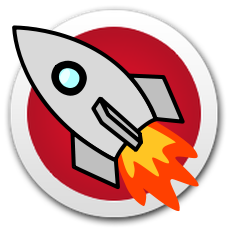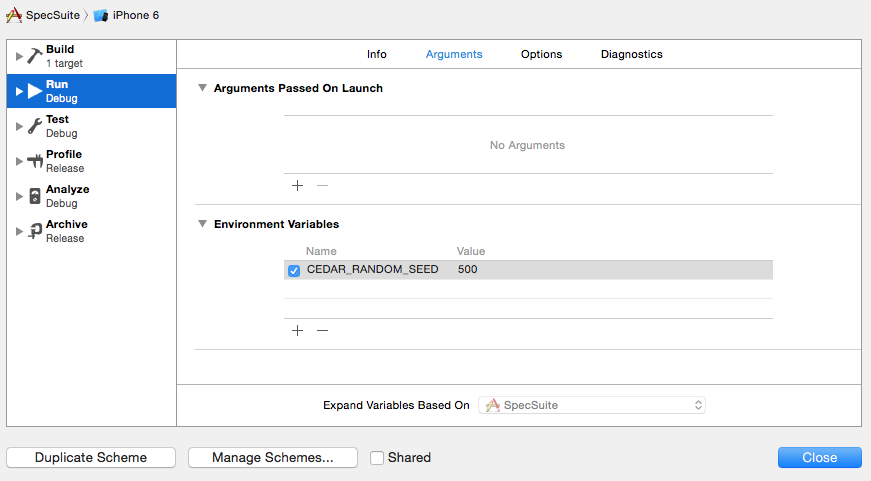
(contact avonderhaar@pivotal.io if you need access)
Thrust is a small project that contains some useful rake tasks to run Cedar specs and build iOS app archives for deployment.
rake autotag:create[environment] # Create a tag for the given deployment environment
rake autotag:list # Show the commit that is currently deployed to each environment
rake build_ipa:demo # Build an .ipa file for deployment to demo
rake build_ipa:production # Build an .ipa file for deployment to production
rake build_ipa:staging # Build an .ipa file for deployment to staging
rake clean # Clean all targets
rake focused_specs # Print out names of files containing focused specs
rake nof # Remove any focus from specs
rake set_build_number[build_number] # Set build number
rake spec_bundle[device_name,os_version] # Run the FakeProject scheme
rake spec_suite[device_name,os_version] # Run the SpecSuite target
rake mac_suite[device_name,os_version] # Run the MacSpecSuite target
rake trim # Trim whitespace
(Note: Thrust requires ruby >= 1.9.3)
Thrust should be installed as a gem. It comes with an installer that will set up your Rakefile and create an example configuration file.
gem install thrust
thrust install
After installation, change the name of thrust.example.yml to thrust.yml and update the configuration as needed.
If you're using Thrust to run specs for an iOS app and do not have ios-sim installed, you can find it at https://github.com/phonegap/ios-sim or install it using homebrew:
brew install ios-sim
If you had Thrust previously installed as a submodule, we recommend that you remove the submodule and now use Thrust as a gem. This is because there are runtime dependencies that will not get installed properly if Thrust is installed as a submodule.
See CHANGELOG.md for the full list of changes.
-
Drops support for automated deploys to TestFlight, since testflightapp.com no longer exists. We recommend that you use Thrust in conjunction with another gem that supports automated deploys, e.g. shenzhen or deliver.
-
Adds rake tasks for building an .ipa file for deployment. The rake tasks use the existing TestFlight deployment configurations to build the .ipa's. The keys that are still used are:
targetbuild_configurationprovisioning_search_queryversioning_methodtag
-
Drops Android support. If you want to use Thrust to deploy Android apps to TestFlight, use version 0.5.2.
-
Drops
iosprefix from keys inthrust.yml:ios_spec_targets=>spec_targetsios_distribution_certificate=>distribution_certificatedeployment_targets>ios_target=>targetdeployment_targets>ios_provisioning_search_query=>provisioning_search_querydeployment_targets>ios_build_configuration=>build_configuration
-
Adds
spec_directoriesconfiguration key tothrust.yml. This allows you to specify from whererake nofremoves focused specs. -
Updates
spec_targetsto require theschemename instead of thetargetname. Thetargetkey is no longer used. -
Adds support for specifying the MacOSX sdk version in a spec target configuration. E.g.
build_sdkcan now be set tomacosx10.9ormacosx10.10. Runxcodebuild -showsdksto see the full list of available sdks. -
Adds support for specifying the Cedar random seed for spec targets (note that this is not currently supported for spec bundles):
CEDAR_RANDOM_SEED=5 bundle exec rake spec_suite
- Adds support for reading environment variables set in the scheme.
e.g. If you set a CEDAR_RANDOM_SEED in the spec target's scheme in Xcode, the spec task will run with that random seed:
See the Cedar wiki for a list of all available Cedar environment variables.
If you are using a spec bundle, you will need to set the environment variable in the scheme for the main app target.
As of version 0.7, Thrust no longer supports automated deploys to TestFlight. This is because testflightapp.com no longer exists as of February 26, 2015. We recommend that you use Thrust in conjunction with another deployment gem, such as shenzhen or deliver.
Here is an example of how you might use Thrust with the deliver gem:
export DELIVER_USER=<iTunes Connect Username>
export DELIVER_PASSWORD=<iTunes Connect Password>
bundle exec rake build_ipa:staging | tail -n 1 | xargs deliver testflight -a <Apple ID>
bundle exec rake autotag:create[staging]The Apple ID is a unique identifier assigned to your app in iTunes Connect. Find it in iTunes Connect under:
My Apps -> [App Name] -> More -> About This App -> Apple ID
thrust_version: 0.6
project_name: My Great Project # do not use if building with an xcode workspace
# workspace_name: My Workspace # use if building with an xcode workspace
# path_to_xcodeproj: 'App/MyApp.xcodeproj' # use if xcodeproj is not in the same directory as this yaml file. Optional.
app_name: My Great App
distribution_certificate: 'Name of Distribution Signing Certificate'
#ios_sim_path: '/path/to/ios-sim' # Optional. Use to prefer a specific ios-sim binary (e.g. within project directory) over a system-installed version (homebrew)
deployment_targets:
staging:
target: MyGreatAppTarget # Name of the build target. Optional, defaults to app name.
build_configuration: Release
provisioning_search_query: 'query to find Provisioning Profile' # Otherwise, it will use the first provisioning profile in ~/Library/MobileDevice/Provisioning Profiles/
versioning_method: 'none' # or 'timestamp-sha' or 'commits'. Leave blank to use Git commit SHAs for build numbers.
tag: ci # Deploys latest commit with the tag. Leave blank to deploy from master.
demo:
build_configuration: Demo
provisioning_search_query: 'query to find Provisioning Profile'
spec_targets:
# Example of an iOS spec suite configuration.
specs: # This is the name of the rake task
scheme: Specs (My Great App) # Name of the scheme.
type: app # Spec target type: 'app' or 'bundle'. Optional, defaults to app.
build_configuration: Debug # Name of the build configuration.
build_sdk: iphonesimulator8.1 # SDK used to build the target. Optional, defaults to latest iphonesimulator.
device_name: iPhone 6 # Device name. Run `ios-sim showdevicetypes` to see a full list of available devices.
os_version: 8.1 # OS version to run. Optional, defaults to latest available version.
timeout: 90 # Optional, defaults to 30 seconds.
# Example of an iOS spec bundle configuration.
spec_bundle:
scheme: My Great App # Use the name for the main app scheme.
type: bundle
build_configuration: Debug
device_name: iPhone 4s
os_version: 7.1
# Example of a Mac OSX target configuration.
integration:
scheme: IntegrationSpecs (My Great App)
build_configuration: Release
build_sdk: macosx
spec_directories:
- SpecSuite
- SpecBundle
- WatchKit/SpecBundle
- MacSpecSuiteYou can change the API token for a TestFlight upload with the TESTFLIGHT_API_TOKEN environment variable. This is useful when different members want to use their own tokens to deploy without having to change thrust.yml and commiting again.
TestFlight deployment requires you to be in a clean git repo and to be at the head of your current branch. You can disable this by setting the environment variable IGNORE_GIT=1. We do not recommend this. If your git repository is not clean, deployment will discard all your uncommitted changes.
Deploying to TestFlight will automatically notify all of the people on your TestFlight distribution list. If you would prefer not to notify them, then you can change the notify value in thrust.yml for that distribution list. You can also set the environment variable NOTIFY to false, e.g:
NOTIFY=false rake testflight:staging
Periodically new thrust versions will require changes to your thrust.yml configuration. Look in the Upgrading Instructions section below for guidance on how to upgrade from the previous version. If you need to upgrade multiple versions, you may want to just re-create your configuration from the example.yml.
Once you upgrade make sure to add/update the 'thrust_version' key in the configuration to the new version.
-
Remove the
testflightsection from yourthrust.yml. -
Clean up the
deployment_targetsconfigurations to no longer include deprecated keys:distribution_list,notify,note_generation_method. -
See the Automated Deployments section above for instructions on how to set up automated deployment using Thrust with the deliver gem.
-
In your
thrust.yml, update all spec configurations underspec_targetsto specify the specschemeinstead of thetarget. -
Rename
ios_prefixed keys (ios_spec_targets,ios_distribution_certificate,ios_target,ios_provisioning_search_query,ios_build_configuration) to no longer include theios_prefix.
Version 0.5 required many updates to Thrust thanks to the releases of Xcode 6, Yosemite, and ios-sim 3.0. In order to update successfully to version 0.5, we recommend that you:
- Use Xcode 6
- Install or upgrade to ios-sim 3.0 (
brew install ios-simorbrew upgrade ios-sim) - Use OS X Mavericks or Yosemite
There are also significant changes to the keys in the thrust.yml configuration file.
Older thrust.yml files asked for runtime_sdk and device. In Thrust 0.5, these keys have been removed and you should instead specify device_name and os_version in thrust.yml, for example:
...
specs:
device_name: iPhone-6
os_version: 8.1
...
You can run ios-sim showdevicetypes to see the list of available devices and runtime iOS versions.
We recommend generating a new file from the thrust.example.yml and then copying your project configuration into that file. Please see the comments in thrust.example.yml for more information.
You should remove Dir.glob('Vendor/thrust/lib/tasks/*.rake').each { |r| import r } from your Rakefile before running thrust install.
To use Thrust on CI, you should include it in a Gemfile in your project root so the same version of the gem will be installed on the CI box as on your local machine. Your CI box should also have ruby >= 1.9.3, bundler and ios-sim.
Here is an example .sh script for running specs with Thrust on Jenkins (in the Execute shell section of your job configuration).
#!/bin/bash --login
bundle install
git submodule update --init --recursive
CC= bundle exec rake specs
